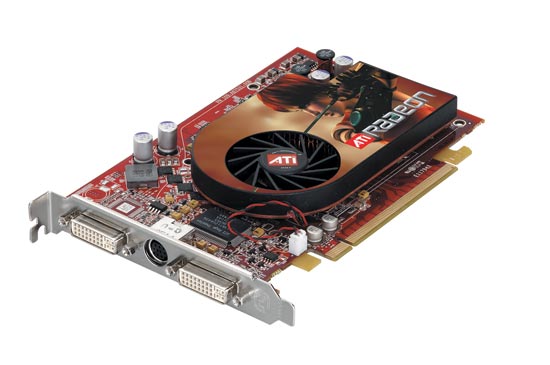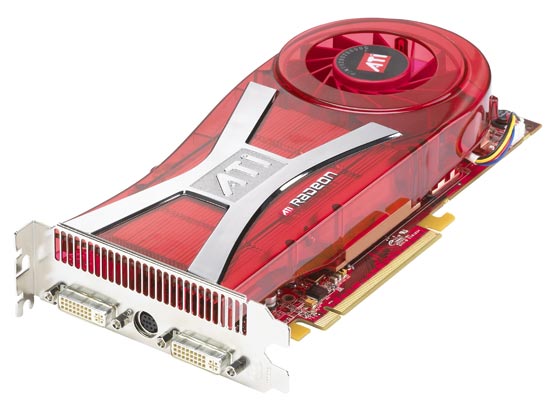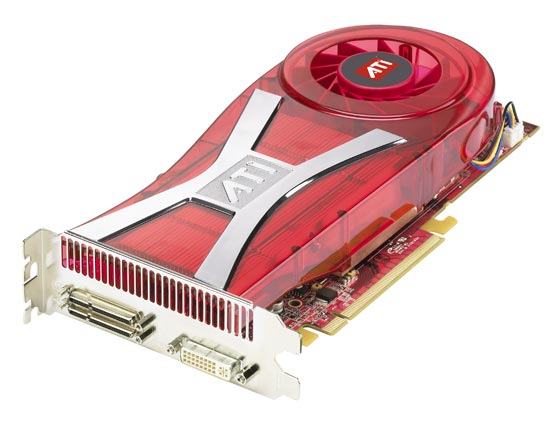ATI's New High End and Mid Range: Radeon X1950 XTX & X1900 XT 256MB
by Derek Wilson on August 23, 2006 9:52 AM EST- Posted in
- GPUs
ATI has this nasty habit of introducing way too many GPUs into its lineup, and today is no letdown to tradition as ATI is introducing a total of five new video cards.
We'll start at the bottom with the Radeon X1300 XT, a new $89 part from ATI. The X1300 XT is effectively a rebadged X1600 Pro, and thus should offer a significant performance boost over the rest of the X1300 family.
Since the X1300 XT is the same thing as an X1600 Pro, the X1600 family gets a new member with the introduction of the X1650 Pro. The X1650 Pro is identical to the X1600 XT except for a 10MHz increase in core clock and memory clock frequency. Yes, an entirely new product was created out of a 10MHz bump in GPU/memory clocks. The X1650 Pro will be priced at $99.

ATI's Radeon X1650 Pro
Last week we took a look at currently available mid-range GPU solutions in the $200 - $300 price range and found that for around $340 you could pick up a 512MB X1900 XT and generally get some very solid performance. Today ATI is introducing a 256MB version of the X1900 XT at the suggested retail price of $279, which has the potential to give ATI a firm grasp on the performance mainstream GPU market. The X1900 XT 256MB is no different than its 512MB brother other than memory size, so pipes and clocks are the same. If you're wondering why the X1900 XT (512MB) noticed such a sharp decline in price over the past couple of weeks, the impending release of the cheaper 256MB version is your answer.
At the high end we've got the final two cards that round out today's launch: ATI's Radeon X1950 XTX and X1950 CrossFire. The X1950 XTX is identical to the X1900 XTX except that it uses faster GDDR4 memory, running at 1GHz compared to 775MHz on the X1900 XTX. With more memory bandwidth, the X1950 XTX could outperform its predecessor, but performance isn't what we're mostly excited about with this card - it's the price. ATI is hoping to sell the X1950 XTX for $449, a drop in price compared to the introductory price of the X1900 XTX, which is a trend we haven't seen too often among GPU makers.

ATI's Radeon X1950 XTX
To make things even better, the CrossFire version, which has identical clocks, is also priced at $449; in other words, there's no reason not to get the CrossFire version. ATI confirmed to us that you can run a pair of X1950 CrossFire cards in CrossFire mode, further reinforcing the fact that there's no reason to even buy the regular card. You get the same performance, same features and better flexibility with the CrossFire card so why not?

ATI's Radeon X1950 CrossFire
| NVIDIA Graphics Card Specifications | ||||||||
Vert Pipes |
Pixel Pipes |
Raster Pipes |
Core Clock |
Mem Clock |
Mem Size (MB) |
Mem Bus (bits) |
Price |
|
| GeForce 7950 GX2 | 8x2 |
24x2 |
16x2 |
500x2 |
600x2 |
512x2 |
256x2 |
$600 |
| GeForce 7900 GTX | 8 |
24 |
16 |
650 |
800 |
512 |
256 |
$450 |
| GeForce 7900 GT | 8 |
24 |
16 |
450 |
660 |
256 |
256 |
$280 |
| GeForce 7600 GT | 5 |
12 |
8 |
560 |
700 |
256 |
128 |
$160 |
| GeForce 7600 GS | 5 |
12 |
8 |
400 |
400 |
256 |
128 |
$120 |
| GeForce 7300 GT | 4 |
8 |
2 |
350 |
667 |
128 |
128 |
$100 |
| GeForce 7300 GS | 3 |
4 |
2 |
550 |
400 |
128 |
64 |
$65 |
| ATI Graphics Card Specifications | ||||||||
Vert Pipes |
Pixel Pipes |
Raster Pipes |
Core Clock |
Mem Clock |
Mem Size (MB) |
Mem Bus (bits) |
Price |
|
| Radeon X1950 XTX | 8 |
48 |
16 |
650 |
1000 |
512 |
256 |
$450 |
| Radeon X1900 XTX | 8 |
48 |
16 |
650 |
775 |
512 |
256 |
$375 |
| Radeon X1900 XT | 8 |
48 |
16 |
625 |
725 |
256/512 |
256 |
$280/$350 |
| Radeon X1900 GT | 8 |
36 |
12 |
525 |
600 |
256 |
256 |
$230 |
| Radeon X1650 Pro | 5 |
12 |
4 |
600 |
700 |
256 |
128 |
$99 |
| Radeon X1600 XT | 5 |
12 |
4 |
590 |
690 |
256 |
128 |
$150 |
| Radeon X1600 Pro | 5 |
12 |
4 |
500 |
400 |
256 |
128 |
$100 |
| Radeon X1300 XT | 5 |
12 |
4 |
500 |
400 |
256 |
128 |
$89 |
| Radeon X1300 Pro | 2 |
4 |
4 |
450 |
250 |
256 |
128 |
$79 |
Today we're able to bring you a look at performance of the mid range and high end solutions, the X1950 cards and 256MB X1900 XT. We're still waiting for ATI to send us our X1300 XT and X1650 Pro samples, and we will follow up in the coming weeks with a look at the performance of those offerings as well. Note that although ATI is lifting the veil on its five new products today, you won't actually be able to buy any of them until September 4th (on the high end) with no real availability until the 14th. Given the pricing that ATI is promising however, these cards are worth waiting for.
With five new cards being introduced, ATI is hoping to slowly phase out all of its other offerings to simplify its product lineup. Unfortunately, it will take some time for all inventory to dry up, but when it does ATI hopes to have the following cards in its lineup:
| Class | Card | Price |
| Enthusiast | ATI Radeon X1950 XTX | $449 |
| ATI Radeon X1900 XT 256MB | $279 |
|
| Performance | ATI Radeon X1900 GT | $249 |
| Mainstream | ATI Radeno X1650 Pro | $99 |
| ATI Radeon X1300 XT | $89 |
|
| Value | ATI Radeon X1300 Pro | $79 |
| ATI Radeon X1300 256 | $59 |
|
| ATI Radeon X1300 64-bit | $49 |
The performance difference between the X1900 XTX and XT was small enough that it didn't make sense to have two different products, which is why ATI left the X1950 XTX as the only high end GPU on its roster.
As we don't have availability right now, we can't confirm real street prices, but we did speak with a few companies who manufacture ATI cards. HIS has stated that they should be able to meet ATI's pricing on all of these parts, which is promising. We also heard from PowerColor on pricing, and it looks like they will be able to meet the MSRP price on the X1950 XTX. With the X1900 XT and X1900 XT 256MB, PowerColor will be listing them for $400 and $300 respectively. Depending on how the rest of the manufacturers stack up, we could see some good prices next month or be sorely disappointed; at this point it's best to be cautious with a launch so far in advance of availability.










74 Comments
View All Comments
JarredWalton - Wednesday, August 23, 2006 - link
We used factory overclocked 7900 GT cards that are widely available. These are basically guaranteed overclocks for about $20 more. There are no factory overclocked ATI cards around, but realistically don't expect overclocking to get more than 5% more performance on ATI hardware.The X1900 XTX is clocked at 650 MHz, which isn't much higher than the 625 MHz of the XT cards. Given that ATI just released a lower power card but kept the clock speed at 650 MHz, it's pretty clear that there GPUs are close to topped out. The RAM might have a bit more headroom, but memory bandwidth already appears to be less of a concern, as the X1950 isn't tremendously faster than the X1900.
yyrkoon - Wednesday, August 23, 2006 - link
I think its obvious why ATI is selling thier cards for less now, and that reason is alot of 'tech savy' users, are waiting for Direct3D 10 to be released, and want to buy a capable card. This is probably to try an entice some people into buying technology that will be 'obsolete', when Direct3D 10 is released.Supposedly Vista will ship with Directx 9L, and Directx 10 (Direct3D 10), but I've also read to the contrary, and that Direct3D 10 wont be released until after Vista ships (sometime). Personally, I couldnt think of a better time to buy hardware, but alot of people think that waiting, and just paying through the nose for a Video card later, is going to save them money. *shrug*
Broken - Wednesday, August 23, 2006 - link
In this review, the test bed was an Intel D975XBX (LGA-775). I thought this was an ATI Crossfire only board and could not run two Nvidia cards in SLI. Are there hacked drivers that allow this, and if so, is there any penalty? Also, I see that this board is dual 8x pci-e and not dual 16x... at high resolutions, could this be a limiting factor, or is that not for another year?DerekWilson - Wednesday, August 23, 2006 - link
Sorry about the confusion there. We actually used an nForce4 Intel x16 board for the NVIDIA SLI tests. Unfortunately, it is still not possible to run SLI on an Intel motherboard. Our test section has been updated with the appropriate information.Thanks for pointing this out.
Derek Wilson
ElFenix - Wednesday, August 23, 2006 - link
as we all should know by now, Nvidia's default driver quality setting is lower than ATi's, and makes a significant difference in the framerate when you use the driver settings to match the quality settings. your "The Test" page does not indicate that you changed the driver quality settings to match.DerekWilson - Wednesday, August 23, 2006 - link
Drivers were run with default quality settings.Default driver settings between ATI and NVIDIA are generally comparable from an image quality stand point unless shimmering or banding is noticed due to trilinear/anisotropic optimizations. None of the games we tested displayed any such issues during our testing.
At the same time, during our Quad SLI followup we would like to include a series of tests run at the highest possible quality settings for both ATI and NVIDIA -- which would put ATI ahead of NVIDIA in terms of Anisotropic filtering or in chuck patch cases and NVIDIA ahead of ATI in terms of adaptive/transparency AA (which is actually degraded by their gamma correction).
If you have any suggestions on different settings to compare, we are more than willing to run some tests and see what happens.
Thanks,
Derek Wilson
ElFenix - Wednesday, August 23, 2006 - link
could you run each card with the quality slider turned all the way up, please? i believe that the the default setting for ATi, and the 'High Quality' setting for nvidia. someone correct me if i'm wrong.thanks!
michael
yyrkoon - Wednesday, August 23, 2006 - link
I think as long as all settings from both offerings are as close as possible per benchmark, there is no real gripe.Although, some people seem to think it nessisary to run AA as high resolutions (1600x1200 +), but I'm not one of them. Its very hard for me to notice jaggies even at 1440x900, especially when concentrating on the game, instead of standing still, and looking with a magnifying glass for jaggies . . .
mostlyprudent - Wednesday, August 23, 2006 - link
When are we going to see a good number of Core 2 Duo motherboards that support Crossfire? The fact that AT is using an Intel made board rather than a "true enthusiast" board says something about the current state of Core 2 Duo motherboards.DerekWilson - Wednesday, August 23, 2006 - link
Intel's boards are actually very good. The only reason we haven't been using them in our tests (aside from a lack of SLI support) is that we have not been recommending Intel processors for the past couple years. Core 2 Duo makes Intel CPUs worth having, and you definitely won't go wrong with a good Intel motherboard.